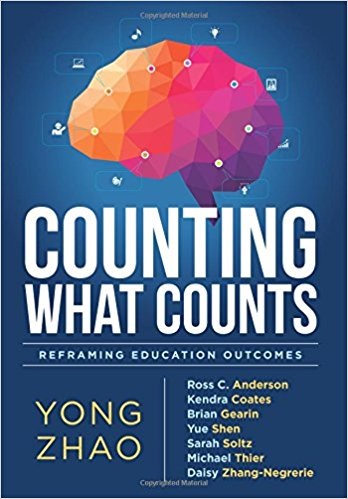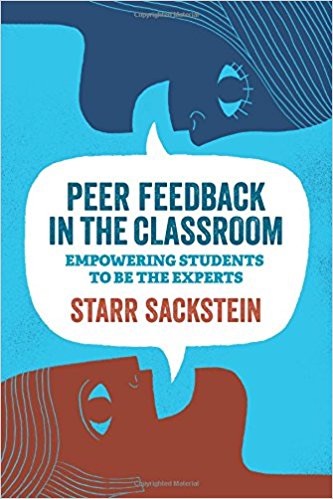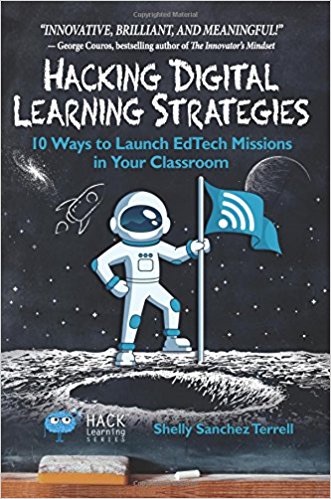Author Archive
Tuesday, December 19th, 2017
Counting What Counts: Reframing Education Outcomes by Yong Zhao and friends takes on the current system with its focus on standardized tests and their sole focus on cognitive skills. Chapters are devoted to defining a variety of non-cognitive skills that are connected with success in life and the current status of how to assess them. They make a case for a new paradigm that would move the system towards more personalized learning and assessment with more focus on non-cognitive skills. Be sure to add this fine book to your professional development library.
Introduction – The Danger of Misguiding Outcomes: Lessons From Easter Island – Yong Zhao
- Yong uses the story of how the natives of Easter Island overexploited the resources in a race to build ever bigger statues. He compares this to the current race to produce students with excellent tests scores. Here he makes the case that the obsession with test scores has and will continue to damage our education ecosystem. It has resulted in cheating, teaching to the test, focusing on students on the pass/fail border, and limiting the focus on subjects not tested. We are destroying teacher autonomy as we ignore real challenges like poverty, unsafe neighborhoods, and unequal access.
- We are striving to produce a homogeneous population rather than supporting diverse talents. Routine knowledge and skills are stressed and they can easily be outsourced or automated. There are many negative side effects that are not considered unlike drug companies that must evaluate and publish side effects of their products. Creativity and non-cognitive skills are ignored. Students good at taking tests might not be good at anything else.
1. Numbers Can Lie: The Meaning and Limitations of Test Scores – Yong Zhao
- Humans are too complex to be reduced to a single number, and such numbers should not be used to make life-changing decisions. Research indicates that IQ tests have limited predictive power. Personality variables like high and stable self-esteem appear to be decisive for life success. SAT and ACT tests are much less predictive of college success than a student’s high school GPA. After many years, the Common Core Standards don’t appear to make students college ready, while motivation, time management skills, and awareness of postsecondary norms and culture do.
- A look at international tests shows that U.S. students have been bad at test taking for a long time. Such scores would suggest that by now the U.S. would be an economic backwater, but the facts suggest otherwise. It’s possible that countries that obsess about tests more than we do have discouraged the cultivation of creative and entrepreneurial spirits.
Posted in Book Summaries, Education Books, Leadership Books | Comments Off on Counting What Counts: Reframing Education Outcomes by Yong Zhao & Friends
Friday, December 15th, 2017

Ways To Prepare Students For Jobs That Don’t Exist Yet by Catrin Cooper will help students, parents, and anyone with a job at risk of automation understand the type of skills and knowledge they need to develop as old jobs disappear and new ones take their place. Educators should also pay attention to these concepts as they develop future lessons.
Introduction
- A decade ago, social media manager was just an imaginary job title to most of us, and so was mobile app developer. With the increasing popularity of social media and the accelerating pace of technology, most of the children today will have jobs that don’t exist yet. This makes it difficult for kids to know what to study when it comes to future careers. So, how can you prepare your kids for a future career that no one can predict yet? The answer is to give young people the vital skills to adapt.
Complex problem-solving skills
- Scientific knowledge and literacy, as well as numeracy, are still vital. However, executives from world’s leading companies think that complex problem solving is the number one job skill in 2020 and beyond.
- Kids with strong problem-solving skills can have a promising career. Problems are always the center of what people do at work each day. Being a problem solver is vital to your success. With this skill, you can solve a problem quickly and effectively.
- Students must learn how to use tools and techniques that can enhance their approach to solving the problems faced by teams and organizations. If you are more successful at solving problems, you will be more successful at what you do. It’s vital to build a reputation as one who can handle tough situations in a positive way.
Critical thinking
- Can you analyze how you think and present evidence for your ideas? Mastering this skill will give you better control of your learning and empathy for other points of view. It is self-directed and self-disciplined thinking. It can help you in communicating effectively and solving problems more efficiently. Critical thinking is a vital skill so that you can think clearly and rationally. This skill is vital in research, blockchain in real estate, finance, and the legal profession. However, it is not restricted to these areas. If you can think well and solve problems, then you have an asset that you can use for any career that you wish to follow.
- This skill involves logic and reasoning. You need to use it to interrogate a problem, consider solutions to the problem, and weigh the pros and cons of every approach. A few years from now, organizations will see individuals with critical thinking skills as highly employable.
- How can critical thinking be integrated into a curriculum? Essay writing is a tried-and-tested method to help students engage in the critical thought process. But there are other more tools available.
Collaborative skills
- Humans could not have risen to prominence by working alone. That’s why students have to learn how to collaborate with others and develop that skill. In a modern workplace, teamwork is increasingly vital. Having social skills is also critical. Over the years, companies have put more emphasis on the interpersonal skills of their employees.
- Learning how to collaborate with others is vital in any work environment, and it is a skill that humans are still better at than robots. Keep in mind that in a workplace, interaction is critical. Workers support one another’s strengths, and they adapt flexibly to various circumstances. This non-routine communication is always a human advantage.
- But to coordinate with others, you need to have strong communication skills. It is a skill that requires awareness of people’s strengths and weaknesses. Furthermore, you need to practice working with different personalities.
Creativity
- There are always new products and new technologies. Thus, employees will need to be more creative to benefit from those changes. Although robots can help us in getting what we want and put some at risk of losing their jobs, they are not as innovative as humans.
- In the future, creativity is a key skill when looking for a job. Just because you consider yourself as a non-creative person, you should remember that it is not exclusive to musicians, artists, and writers. Creativity means that you can connect the dots using diverse information to pull ideas together to have a new idea.
People management
- Even though most tasks in the future are automated and utilize advanced AI, employees will still be a critical part of a company. That’s because humans are more creative than robots. They are better at reading one another. Plus, they support each other’s ideas and energy. Unfortunately, humans get sick and distracted.
- Hence, companies will need managers and team leaders who know how to motivate their teams and maximize their productivity. In that way, they can easily respond to their needs. To be a great manager, you need to enhance your emotional intelligence and learn how to delegate tasks. Furthermore, you should develop your management style. Consider taking a leadership course or two and pick up some leadership books.
Ability to help people
- Having a service orientation is a skill that most companies will need today and in the future. If you have strong skills in this area, you can easily spot and anticipate the future needs of customers. Businesses in the energy department, for instance, would face consumer concerns about carbon footprints, food safety, and labor standards. Companies will have to learn to anticipate new consumer values so that they can translate these issues into product offers.
- With a service orientation, you can step into the minds of users and know what they value, dislike and fear most. From there, you can develop new products or adapt a service to future proof your brand.
Being flexible
- This is about being a mental gymnast. Cognitive flexibility is about how quick you can swing and twirl back and forth from one system to another. You need to be limber to see new patterns and make a unique association of ideas easily. To flex your cognitive muscles, you should learn new things every day and learn new ways to think. For example, you can learn an instrument or try an art class. Or you can read The Economist or The Economic Review to know about financial markets.
- When you expand your interests and go outside your comfort zone, you are embracing people who are challenging your worldviews. Doing it every day will prepare you for a job that does not exist yet. And your brand will thank you for it.
Negotiation skills
- Robots may be good at automating jobs, but they do not have social skills, which will be a more important skill in the future. Humans are better at social interaction. We’re also better at negotiations than robots. Even if you are in the technical department, you need to show better interpersonal skills and be able to negotiate with clients, teams, and managers.
Catrin Cooper
- Catrin is blogger and freelance writer from New York. She’s always ready to cover topics related to personal development, marketing, and education. Feel free to contact Catrin at catrincooper99@gmail.com. Her guest posts are free so don’t miss an opportunity to add some value to your blog.
Posted in Guest Posts | Comments Off on Ways To Prepare Students For Jobs That Don’t Exist Yet by Catrin Cooper
Tuesday, December 12th, 2017
3 Ways Schools Can Use SMS to Reach Students During the Holidays by Ken Rhie explains how the power of sending group text messages can allow any school to run more efficiently. He also tells why such a powerful resource is especially important during the holiday season. If you don’t already have this capability, Ken has a product for you.
Introduction
- Many schools have already discovered that mass texting software can be beneficial for improving communication with parents, staff members, and students. Although this is true during every part of the school year, it is especially important during the holidays. During this time, your institution needs to make sure everyone involved in school activities are kept up-to-date on events, schedule changes, and other important announcements. Here are three ways your school can use SMS during the holiday season.
1. For holiday school events
- Most schools schedule special events during the holidays, such as holiday parties, programs or even fundraisers. Using SMS messaging, you can make sure everyone in your school knows when these events will take place. For example, if the classrooms in your school are having Christmas parties on a specific day, you can mass message parents of students to let them know when the party will take place. You can also use texting to explain any rules or other important information related to the event. Should the event be canceled or postponed, you can use SMS messaging to inform everyone involved of the change.
- For people involved in the planning of a special event, you can use SMS messaging to facilitate communication within the group and keep everyone up-to-date on event planning progress.
2. To discuss the holiday schedule
- In most cases, your school’s schedule will change during the holidays. You may have certain days when school won’t be in session, and/or you may be releasing students early on specific days so they can enjoy more time with their families. Schools using mass texting for communication can send messages to parents, students and staff informing them of these schedule changes. Be sure to send a reminder before the change occurs to make sure everyone is on the same page. Encourage all parents, students and staff members to opt into this notification system so they won’t ever be in the dark about scheduling issues.
- In addition, during the holiday season, inclement weather may force your school to delay sessions or close for the day. Using SMS messaging, you can inform staff and students of any cancellations or delays as soon as the decision is made.
3. To send reminders
- During the holidays, your students or staff may have specific deadlines they need to meet. For example, teachers may need to turn in grades before leaving for the holiday break. Likewise, students may need to complete all of the paperwork associated with a holiday fundraiser, or they may need to remember to attend an important meeting related to a holiday event. Whenever any group of people in your school needs to be reminded of a deadline, meeting or other task, you can use SMS messaging to make sure they don’t forget. With the right text messaging software, you can create customized lists of SMS recipients so your messages are sent only to those people who need to see them, allowing you to use SMS messaging to communicate with virtually any group of people affiliated with the school.
- These are just a few of the ways you can put SMS messaging to good use during the holiday season. SMS technology is a powerful tool for your school throughout the rest of the year as well. It provides many benefits, including instantaneous communication, affordability, convenience and much more. When you utilize this tool properly, you can enhance the efficiency of your school’s operations and improve communication with parents, staff and students.
Ken Rhie
- Ken is the CEO of Trumpia.Com which earned a reputation as the most complete SMS solution including user-friendly user interface and API for mobile engagement, Smart Targeting, advanced automation, enterprise, and cross-channel features for both mass texting and landline texting use cases. Mr. Rhie holds an MBA degree from Harvard Business School. He has over 30 years of experience in the software, internet, and mobile communications industries.
Posted in Guest Posts | Comments Off on 3 Ways Schools Can Use SMS to Reach Students During the Holidays by Ken Rhie
Friday, November 10th, 2017
Peer Feedback in the Classroom: Empowering Students to be the Experts by Starr Sackstein tells the story of how she introduced peer feedback and all of its benefits into her classroom and how it can be applied in other subjects. If you try this, not only will your students develop knowledge and skills better, they will also learn vital collaboration and social skills. Buy one for your school now.
Part 1: The Power of Feedback – 1. The Rational for Teaching Students to Provide Peer Feedback
- Every student has the potential to be an expert in something. Step one is to get to know the students so you can identify and expand their strengths. This can allow the students to share their strengths, perspective, ideas, and preferences. This shows students that there is no one right way to learn or teach. Today it is common for students to know more about some topics than teachers do. This should be exciting as students can share expertise. Technology is an area where this often happens.
- The big idea here is to build trust and enthusiasm, which may not be easy and will take time. A key is to teach students self-advocacy. This will make it easier to address specific needs as students will bring them to you. This should start in kindergarten. This will also serve students throughout their lives. In short, students need to know when they need help and how to get it. Asking peers to help can be a great way to grow. Like all chapters, this one ends with reflection questions for teachers.
2. Developing a Supportive Classroom Culture
- Your initial focus is to develop a welcoming respectful learning environment that supports risk-taking and honest sharing. Students need to be comfortable sharing their work and gain confidence in providing feedback. You have to know your students if you are going to develop rapport so start by finding out what you can about their lives and outside interests as you share some of yourself. Respect can’t be assumed; it must be taught explicitly and modeled continuously. Starr suggests you use surveys to learn about students and provides some samples.
- Rituals and routines are essential to developing rapport. You don’t want to be too flexible and you must establish clear expectations. It might help to have students produce things that are intentionally inferior. They should feel safe correcting these items and see that it’s ok to be wrong. The teacher needs to model feedback intentionally so students can see what is expected. This will include praise and questions that should prompt students to think about how to improve their work. Be sure to share errors you have made. Once your rituals are in place you can give students more control as you facilitate from the side. Starr gives examples from her student newspaper class and another teacher’s fifth-grade class.
-
3. What Meaningful Feedback Looks Like
- Step one is to set clear goals and criteria for success. For each assignment, you need to ask is this worthy of feedback? Use questioning activities and discussions and connect work to prior and future learning. Align learning objectives with standards and the big picture of the lesson. Make sure students see exemplars so they know what mastery looks like, but not ones that are identical to the current assignment.
- Feedback needs to be specific, timely, and delivered in a way that works for the receiver. Focus on one or two points at a time. Rather than saying good job, let them know how they have improved their ability to do something specific. When you are critical, provide suggestions for how to improve something. Limit your feedback to the material covered. Avoid giving feedback too soon as you will end up owning the work yourself. Feedback from teachers should be private. Look for nonverbal cues as you give feedback and adjust your tone accordingly. If a student is shutting down say something encouraging and revisit the issue later.
Posted in Book Summaries, Education Books, Leadership Books | Comments Off on Peer Feedback in the Classroom: Empowering Students to be the Experts by Starr Sackstein
Saturday, November 4th, 2017
Hacking Digital Learning Strategies: 10 Ways to Launch EdTech Missions in Your Classroom by Shelly Sanchez Terrell offers specific lesson plans for integrating technology and engaging students in real-world activities. This book has everything you need including cautions that can help you avoid unexpected problems. Every school should grab a copy to pass around. Then get one for each teacher.
Introduction: Mission-based learning to inspire students
- Technology has empowered our students, who now have the potential to learn anything in exciting ways. Students like to connect and share and now they can. They can also do scary things such as bullying and posting inappropriate images. While they navigate the digital world it’s time to guide them to make more meaningful choices. This book outlines ten missions to inspire students to reflect on their responsibilities as citizens navigating the digital and physical worlds. We should tie school lessons and activities to meaningful purposes that go beyond making good grades or passing tests.
Mission 1. Design a Game Walkthrough: Create a tutorial and teach others how to play.
- Shelly starts with a story of how she decided to let her ESL students teach the world’s religions to each other. She knew they knew more than she did. It was totally hands-on as the students dressed in customary attire, played music, and showed artifacts. They practiced dances, learned songs, and participated in rituals. Everyone learned so much, including Shelly! She learned that learning is more powerful when students take the reins. Unfortunately, traditional teaching doesn’t work this way.
- For this mission, your students will create a video tutorial about one of their favorite activities – playing games. Producing a video walkthrough develops students’ reading
and writing skills with digital media. Students learn how to write simple, clear, and concise instructions. Like all of the missions in this book, Shelly provides plenty of detail so teachers should be ready to go. Teachers should have some exemplars to show students, involve students in giving and receiving feedback, and the idea that they can always make their work better. She recommends posting student work online and like all missions provides potential obstacles such as complaints from parents and administrators.
Mission 2. Go on a Selfie Adventure: Define yourself through images.
- Taking selfies is an important part of a student’s sense of self, self-belief, and self-esteem. When students post selfies, they realize that their peers will perceive and rate them. Selfies they take often focus on their physical features and fail to capture their
important moments, experiences, struggles, and successes. To complete this mission, students must take selfies that meet different challenges. Each challenge shows students how to capture better selfies that more effectively tell the stories of their lives. Each selfie also guides young content creators to build a strong digital identity.
- Provide at least five criteria for this selfie mission. Possible challenges include taking a selfie with a pet, a favorite book, a favorite teacher, a hobby, or a favorite food. Instruct students to take selfies at different times of the day, in different environments, and engaged in different learning experiences. They will then create a digital story that they can share with the class. Ideally, the mission will motivate kids to reflect on what makes them unique and to experience life as individuals no matter how their peers perceive them. Depending on the class, teaching photography concepts may be necessary.
Mission 3. Create a Fictional Social Media Profile: Manage your digital footprint more purposefully.
- Many schools filter and ban social media to avoid having students encounter the dark side of the internet on their watch. This means our learners are navigating the vast digital world with no guidance or support. For this mission, students create a social media profile for an historical figure and manage the posts, shares, and exchanges for at least five days. Their choices will either enhance or sully the credibility and reputation of their historical figures. After this experiment, students determine if their shares, posts, reactions, and behavior hindered their historical figures’ contributions to the world.
- Based on what they learned, the class can come up with a list of social media best
practices to protect their digital footprints and manage their digital reputations. This requires that they know the history surrounding their person as they apply it to the social media footprint. It also requires critical thinking as they evaluate their effort. Be sure that administrators and parents know what is going as some schools and parents don’t want kids on social media let along using it as a learning tool.
Posted in Book Summaries, Education Books | Comments Off on Hacking Digital Learning Strategies: 10 Ways to Launch EdTech Missions in Your Classroom by Shelly Sanchez Terrell










